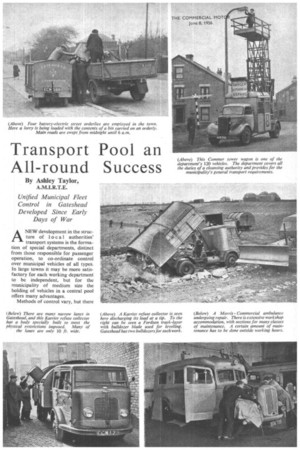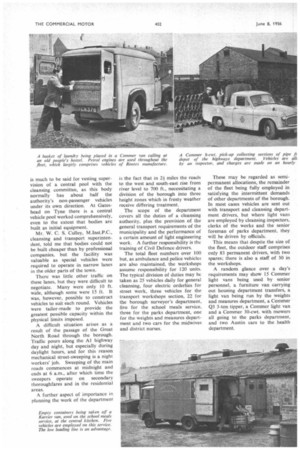Transport Pool an All-round Success
Page 77

Page 78

Page 79

If you've noticed an error in this article please click here to report it so we can fix it.
By Ashley Taylor, A.M.I.R.T.E.
Unified Municipal Fleet Control in Gateshead Developed Since Early Days of War
ANEW development in the structure of local authorities' transport systems is the formation of special departments, distinct from those responsible for passenger operation, to co-ordinate control over municipal vehicles of all types. In large towns it may be more satisfactory for each working department to be independent, but for the municipality of medium size the holding of vehicles in a central pool offers many advantages.
Methods of control vary, but there is much to be said for vesting supervision of a central pool with the cleansing committee, as this body normally has about half the authority's non-passenger vehicles under its own direction. At Gateshead on Tyne there is a central vehicle pool worked comprehensively, even to the extent that bodies are built as initial equipment.
Mr. W. C. S. Culley, M.Inst.P.C., cleansing and transport superinten-, dent, told me that bodies could not be built cheaper than by professional companies, but the facility was valuable as special vehicles were required to operate in narrow lanes in the older parts of the town.
There was little other traffic on these lanes, but they were difficult to negotiate. Many were only 10 ft. wide, although some were 15 ft. It was, however, possible to construct vehicles to suit each round. Vehicles were tailor-made to provide the greatest possible capacity within the physical limits imposed.
A difficult situation arises as a result of the passage of the Great North Road through the borough. Traffic pours along the Al highway day and night, but especially during daylight hours, and for this reason mechanical street-sweeping is a night workers' job. Sweeping of the main roads commences at midnight and ends at 6 a.m., after which time the sweepers operate on secondary thoroughfares and in the residential areas.
A further aspect of importance in planning the work of the department is the fact that in 2f miles the roads to the west and south-east rise from river level to 700 ft., necessitating a division of the borough into three height zones which in frosty weather receive differing treatment.
The scope of the department covers all the duties of a cleansing authority, plus the provision of the general transport requirements of the municipality and the performance of a certain amount of light engineering work. A further responsibility is the training of Civil Defence drivers.
The total fleet numbers over 100 but, as ambulance and police vehicles are also maintained, the workshops assume responsibility for 120 units. The typical division of duties may be taken as 25 vehicles daily for general cleansing, four electric orderlies for street work, three vehicles for the transport workshops section, 22 for the borough surveyor's department, five for the school meals service, three for the parks department, one for the weights and measures department and two cars for the midwives and district nurses. These may be regarded as semipermanent allocations, the remainder of the fleet being fully employed in satisfying the intermittent demands of other departments of the borough. In most cases vehicles are sent out with transport and cleansing department drivers, but where light vans are employed by cleansing inspectors, clerks of the works and the senior foreman of parks department, they will be driven by officials.
This means that despite the size of the fleet, the outdoor staff comprises only 83 permanent drivers, with two spares; there is also a staff of 30 in the workshops.
A random glance over a day's requirements may show 15 Commer light vans being used by senior personnel, a furniture van carrying out housing department transfers, a light van being run by the weights and measures department, a Commer Q3 3-ton tipper, a Commer light van and a Commer 30-cwt. with mowers all going to the parks department, and two Austin cars to the health department. The borough surveyor's department may be noted as taking a group of Commer tippers, varying in capacity from 2 tons to 7 tons, as well as five small vans and two tower wagons. Then the building section will have two lorries and two vans.
The cleansing department's share may well be 18 !Carrier refuse collectors, two 1Carrier-Yorkshire gullyemptiers, two sweepers, four Comrner vans, and two bulldozers for refusetip work. In addition there will be the four pedestrian-controlled electric orderlies.
Allocation of the vehicles is made by a transport inspector on the basis of requisitions received 24 hours in advance of requirement. They can be hired for hours, days or weeks at a time, but in any event are charged out on an hourly non-profit basis which covers all costs. The various units are placed in capacity and use groupings, charging being based on the actual income and expenditure of each group. "
Born Out of War The beginning of the Gateshead transport pool goes back to the early days of the last war when the somewhat limited resources available were concentrated in the one depart ment. At first, additional vehicles had to be acquired from Service surplus stocks.
These units were then adapted to municipal requirements in the transport and cleansing department workshops. As time has gone on the fleet has been standardized, so far as possible, with Commer, Karrier and Hillman as the principal makes.
The workshops quickly exhibited a capacity for bodybuilding and, as already indicated, most vehicles are now purchased in chassis form and completed to the department's requirements.
A notable exception is a unit employed for collecting refuse from flits. This has a Glover, Webb and Liversidge body on a Gamecock chassis. The ordinary side-loaders are built in varying capacities from 9 cu. yd. to 15 cu. yd. Commer tippers range from 30 cwt. to 7 tons.
Petrol engines are used throughout the fleet, although oil-engined units are employed for certain pieces of plant, which are also responsibilities of the department.
Much of the engineering equipment is in regular use by the borough surveyor's or transport and cleansing department but, to satisfy a demand from local contractors, various units are available for outside hire, payment in such instances being at the approved rates of the Contractors' Plant Association. The equipment includes bulldozers, dumpers, pumps, concrete-mixers, compressors, road rollers, lifting shovels, overloaders and a heavy mobile crane.
Extensive workshops accommodation at Park Road provides for sections devoted to motor and general engineering, blacksmiths', sheet-metal and electrical work, painting and cellulosing, tyre repairs, welding and bodybuilding. The department undertakes repairs arising out of accidents to the municipal vehicles, the cost in such instances being charged out to the insurers.
Because the fleet is normally fully employed, a certain amount of maintenance has to be performed outside working hours, as are general service and vehicle inspections. A continuous-duty system is operated, there being a greasing and service crew of two working every night. One of the men assigned to these duties must be a driver capable of carrying out shunting work. Although the department does not operate on a profit-making basis, the organization has to pay its way and, during the most recent year for which complete figures are available, the income from the vehicles amounted to over £78,000. Mr. Culley told me that, taking standard commercial types as an example, his department could hire out at up to Zs. an hour less than the rates charged by private contractors • for similar machines.
All vehicles come under close personal supervision at the depot and each will normally receive a top overhaul at approximately 10,000 miles. The load carriers have engines with chromium cylinder boxes, and records show that some have run as long as eight years without any major engineering work being necessary.
All refuse-collection vehicles are taken off the road, completely reconditioned, and repainted every two years. The tippers, which are liable to a certain amount of damage as a result of the rough work which they perform on unsurfaced sites, are brought in as required.
Depreciation Methods First costs are written off over varying periods, the vans being reckoned as good for 10,000 hours, or about four to five years' service. Tippers over 3 tons are given a 10,000-hour life, the smaller tippers 16,000 hours and refuse-collection machines 20,000 hours.
The services operated by the department cover refuse collection and disposal (including the salvage and street cleansing), road gritting and snow removal, transport pool and workshops, farms and piggeries, and public conveniences.
Test weighings show that refuse averages 22.5 cwt. per 1,000 of population per day, a high figure which arises largely from the fact that many colliery workers live in the area.
About three-quarters of the refuse is collected from the narrow back lanes already mentioned, where the bin carries are short and a man will average 140 lifts per day, compared with 90 in the more modern residential districts of the borough.
From the collection areas to the disposal points the average single journey haul is 2.8 miles, but in the summer of 1955, loads generally being light, tips outside the boundary were used, so increasing the haul to 6+ miles but conserving the capacity of the nearer disposal points.
Approximately 47,500 tons of refuse is dealt with annually by controlled tipping.




















































































































































